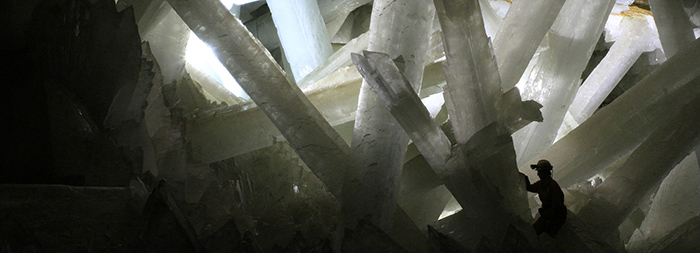Chile's Volcanic Lakes May Hint At Where To Look For Life On Mars

Single celled organisms can be trapped as crystals of gypsum grow, giving scientists a new place to look for life on other planets. The gypsum crystals shown above are from "the Cave of Crystals" in Chihuahua, Mexico.
Crisco 1492 via Wikipedia | http://bit.ly/1i8XZs4
(Inside Science) -- Collecting samples from the volcanic lakes of northern Chile, scientists have discovered microscopic organisms preserved in long, narrow blades of gypsum salt. The discovery, according to researchers, suggests a new way to examine Mars for evidence of life.
It might not just be fossils encased in the Martian salts, either: The gypsum salts from Chile contained tiny bubbles, or "inclusions," filled with water and air. If these imperfections exist in salt crystals found on the Red Planet, they could harbor "a living, yet isolated and likely dormant, microbiological community on Mars today," researchers write in a new study that will be published in an upcoming issue of the journal Geology.
The two Chilean lakes, Salars Gorbea and Ignorado where the crystal-bound organisms were found, are a good analog for some of the environments on Mars, said study coauthor Kathleen Benison, a geologist at West Virginia University in Morgantown. The lakes are nestled in the high Andes amidst several active volcanoes.
"There’s no vegetation. You look around, and it’s this lifeless place. When you’re visiting there, it feels like you’re on another planet," Benison said.
Conditions in the region are too dry for rain or snow, so Salars Gorbea and Ignorado are only sustained by upwelling groundwater that has been turned extremely salty and acidic through interactions with the surrounding volcanic rocks.
"We think the water is interacting with the magma chambers," Benison said.
Strong winds that blow through the area scatter the lake water to create shallow pools. As these pools evaporate, minerals, mainly gypsum, crystallize into translucent, pearly-white blades of salt, many of which are more than a foot long.
To investigate whether life might exist in this harsh landscape, Benison and her graduate student, Francis Karmanocky III, collected some of the crystals and shaved slivers off for study. When the researchers shined a light through the samples and peered at them through a microscope, they were amazed by the diversity of life trapped within the crystal layers. They observed single-celled organisms known as prokaryotes, as well as green algae, including a variety of green algae called diatoms that are encased in silica armor. Some of the microorganisms were entombed in the crystals themselves, trapped in coffins that slowly grew around them. Oftentimes, though, they were found in tiny bubbles filled with air or water.
Some of the fluid inclusions the scientists found contained algae that closely resembled Dunaliella, a type of green algae that is known to live in extremely salty waters and which has the remarkable ability of being able to enter a mode of suspended animation that can last for thousands of years.
"When the water gets too salty, it goes into hibernation," Benison said. "It slows down all of its bodily processes so that it’s alive but not active. And when conditions improve, it comes back to life."
Melanie Mormile, a microbiologist at the Missouri University of Science and Technology in Rolla, said the new study could help scientists understand the kinds of biosignatures to look for on Mars. Scientists previously knew that microorganisms could survive in extremely salty and acidic waters, but “the thing that Kathy has done in this paper that takes it to another level is demonstrate that there are microorganisms trapped in these gypsum crystals that form under these extreme conditions,” said Mormile, who was not involved in the study.
Benison argues that life could also be preserved – in both fossil and living forms – on Mars. Spacecraft and robotic rover studies of the Red Planet have already uncovered geologic features that closely resemble the windblown, crystal landscape found around the high-altitude lakes in Chile. Now the discovery that signs of life are preserved in the crystals on Earth raises the possibility that something similar could have happened on our neighboring planet.
"We don’t know of anything that could’ve prevented this scenario from happening on Mars," Benison said.
Proving that such a scenario did happen on Mars will require equipping future lander and rover missions to Mars with some new tools and capabilities. It will require an instrument that can cleave off a thin section of crystal and shine a light through it, and improved microscopy, Benison said.
"Right now, our rovers have excellent cameras that can look at things up close. But we need to get a little bit closer to see the crystal fluid inclusions," which can be as small as 10 microns in diameter, or about one-tenth the width of a human hair, Benison said.
Ker Than is a freelance writer living in the Bay Area. He tweets at @kerthan.
